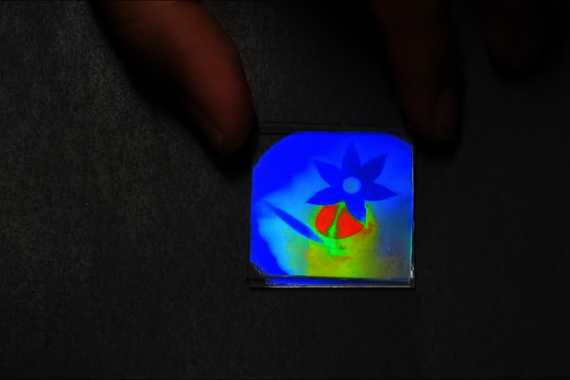Home Stretch | Sustainable colors
The most vivid colors in nature, such as those on butterfly wings and bird feathers, come about through the interference of reflected light. PhD candidate Monali Moirangthem showed that 'structural colors' like these can also be made in the lab using liquid crystals. She found colorfast, invisible, erasable and temperature-sensitive structural inks.
Most colors that we see around us are what are known as pigmentary colors. They are caused by the absorption of light by color molecules (pigments). A well-known drawback of pigments in paint or ink is that they fade as time passes, as the pigment molecules become damaged by prolonged exposure to light.
Structural colors, by contrast, come about through interference – a process by which beams of light reinforce or, alternatively, extinguish one another, depending on the exact color of the light. This makes structural colors much more colorfast than pigments, explains the Indian PhD candidate Monali Moirangthem. “The color we produce with liquid crystals, which are a certain type of polymer, is determined by how exactly the polymer molecules are arranged. Unlike pigments, this structure is not damaged by light.”
Heating locally
In her group, Stimuli-responsive Functional Materials & Devices, they have plenty of experience of liquid crystals, the molecules used to make, among other things, LCD screens. Moirangthem succeeded in making a coating of liquid crystals, in which she can write permanently colored patterns. “By heating the coating locally using a laser or a ‘hot pen’, we cause certain molecules to evaporate. This changes the local structure of the coating and thus its color. The idea is that in this way you can make extremely stable patterns, in which you could store information that needs to be saved for a long time.”
In a follow-up project Moirangthem and her colleagues produced an erasable ink, and it can be applied with an inkjet printer. “Using a single ink we can produce every color, from violet to red. This is possible because the color is determined by the thickness of the coating.” And these colors too stay good for an extremely long time, she explains. “But, nonetheless, you can easily remove the ink with an organic solvent. That makes this technique attractive for use on, say, advertising billboards. Also because these colors are free of glare in sunlight.”
Invisible
In addition, this Indian academic demonstrated that you can also make an ‘invisible’ ink based on liquid crystals. “We can use it to print pictures that only become visible once you moisten them, by breathing on them, for example. You could use this as a type of watermark.” The trick is that the concentration of calcium in the ink determines the extent to which the ink expands when it is moistened, and thus which color appears. This means that a previously applied pattern came suddenly become visible with the application of a droplet of water (see short film) or moist breath.
Another promising application of liquid crystals that Moirangthem is working on with others is a temperature sensor. This builds on the fact that they can be used to make temperature-sensitive coatings. These change color the longer they are exposed to a certain temperature – for example, upwards of refrigerator temperature. “In principle, these coatings can be used to make labels for food packaging. The color would reveal whether the food should still be fresh.” Her former colleague Koen Nickmans is currently working to refine this technology and launch it commercially with the start-up FreshStrips.
Photo | Bart van Overbeeke
![[Translate to English:] Monali Moirangthem. Foto | Bart van Overbeeke](/fileadmin/_processed_/2/4/csm_BvOF_Monali_Moirangthem_1_88b13eb967.jpg)


Discussion